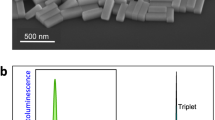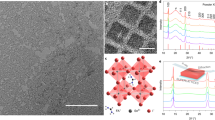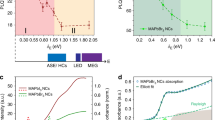Abstract
Understanding the electronic energy landscape in metal halide perovskites is essential for further improvements in their promising performance in thin-film photovoltaics. Here, we uncover the presence of above-bandgap oscillatory features in the absorption spectra of formamidinium lead triiodide thin films. We attribute these discrete features to intrinsically occurring quantum confinement effects, for which the related energies change with temperature according to the inverse square of the intrinsic lattice parameter, and with peak index in a quadratic manner. By determining the threshold film thickness at which the amplitude of the peaks is appreciably decreased, and through ab initio simulations of the absorption features, we estimate the length scale of confinement to be 10–20 nm. Such absorption peaks present a new and intriguing quantum electronic phenomenon in a nominally bulk semiconductor, offering intrinsic nanoscale optoelectronic properties without necessitating cumbersome additional processing steps.
This is a preview of subscription content, access via your institution
Access options
Access Nature and 54 other Nature Portfolio journals
Get Nature+, our best-value online-access subscription
$29.99 / 30 days
cancel any time
Subscribe to this journal
Receive 12 print issues and online access
$259.00 per year
only $21.58 per issue
Buy this article
- Purchase on Springer Link
- Instant access to full article PDF
Prices may be subject to local taxes which are calculated during checkout



Similar content being viewed by others
Data availability
The datasets generated during and/or analysed during the current study are available in the Oxford University Research Archive repository50.
References
Johnston, M. B. & Herz, L. M. Hybrid perovskites for photovoltaics: charge-carrier recombination, diffusion, and radiative efficiencies. Acc. Chem. Res. 49, 146–154 (2016).
Kojima, A., Teshima, K., Shirai, Y. & Miyasaka, T. Organometal halide perovskites as visible-light sensitizers for photovoltaic cells. J. Am. Chem. Soc. 131, 6050–6051 (2009).
NREL Research Cell Record Efficiency Chart (NREL, 2019).
Herz, L. M. Charge-carrier dynamics in organic-inorganic metal halide perovskites. Annu. Rev. Phys. Chem. 67, 65–89 (2016).
Stoumpos, C. C. & Kanatzidis, M. G. Halide perovskites: poor man’s high-performance semiconductors. Adv. Mater. 28, 5778–5793 (2016).
Fu, Y. et al. Metal halide perovskite nanostructures for optoelectronic applications and the study of physical properties. Nat. Rev. Mater. 4, 169–188 (2019).
Polavarapu, L., Nickel, B., Feldmann, J. & Urban, A. S. Advances in quantum-confined perovskite nanocrystals for optoelectronics. Adv. Energy Mater. 7, 1–9 (2017).
Li, M. et al. Amplified spontaneous emission based on 2D Ruddlesden–Popper perovskites. Adv. Funct. Mater. 28, 1707006 (2018).
Parrott, E. S. et al. Growth modes and quantum confinement in ultrathin vapour-deposited MAPbI3 films. Nanoscale 11, 14276–14284 (2019).
Hermes, I. M. et al. Ferroelastic fingerprints in methylammonium lead iodide perovskite. J. Phys. Chem. C 120, 5724–5731 (2016).
Rothmann, M. U. et al. Direct observation of intrinsic twin domains in tetragonal CH3NH3PbI3. Nat. Commun. 8, 6–13 (2017).
Wilson, J. N., Frost, J. M., Wallace, S. K. & Walsh, A. Dielectric and ferroic properties of metal halide perovskites. APL Mater. 7, 010901 (2019).
Röhm, H. et al. Ferroelectric properties of perovskite thin films and their implications for solar energy conversion. Adv. Mater. 31, 1806661 (2019).
Röhm, H., Leonhard, T., Hoffmann, M. J. & Colsmann, A. Ferroelectric poling of methylammonium lead iodide thin films. Adv. Funct. Mater. 30, 1908657 (2020).
Liu, S. et al. Ferroelectric domain wall induced band gap reduction and charge separation in organometal halide perovskites. J. Phys. Chem. Lett. 6, 693–699 (2015).
Montero-Alejo, A. L., Menéndez-Proupin, E., Palacios, P., Wahnón, P. & Conesa, J. C. Ferroelectric domains may lead to two-dimensional confinement of holes, but not of electrons, in CH3NH3PbI3 perovskite. J. Phys. Chem. C 121, 26698–26705 (2017).
Pecchia, A., Gentilini, D., Rossi, D., Auf der Maur, M. & Di Carlo, A. Role of ferroelectric nanodomains in the transport properties of perovskite solar cells. Nano Lett. 16, 988–992 (2016).
Gómez, A., Wang, Q., Goñi, A. R., Campoy-Quiles, M. & Abate, A. Reply to the “Comment on the publication ‘Ferroelectricity-free lead halide perovskites’ by Gomez et al.” by Colsmann et al. Energy Environ. Sci. 13, 1892–1895 (2020).
Weller, M. T., Weber, O. J., Frost, J. M. & Walsh, A. Cubic perovskite structure of black formamidinium lead iodide, α-[HC(NH2)2]PbI3, at 298 K. J. Phys. Chem. Lett. 6, 3209–3212 (2015).
McKenna, K. P. Electronic properties of {111} twin boundaries in a mixed-ion lead halide perovskite solar absorber. ACS Energy Lett. 3, 2663–2668 (2018).
Frost, J. J. M. J. et al. Atomistic origins of high-performance in hybrid halide perovskite solar cells. Nano Lett. 14, 2584–2590 (2014).
Lines, M. E. & Glass, A. M. Principles and Applications of Ferroelectrics and Related Materials (Oxford Univ. Press, 1977).
Eperon, G. E. et al. Formamidinium lead trihalide: a broadly tunable perovskite for efficient planar heterojunction solar cells. Energy Environ. Sci. 7, 982–988 (2014).
Wright, A. D. et al. Electron-phonon coupling in hybrid lead halide perovskites. Nat. Commun. 7, 11755 (2016).
Davies, C. L. et al. Impact of the organic cation on the optoelectronic properties of formamidinium lead triiodide. J. Phys. Chem. Lett. 9, 4502–4511 (2018).
Rehman, W. et al. Charge-carrier dynamics and mobilities in formamidinium lead mixed-halide perovskites. Adv. Mater. 27, 7938–7944 (2015).
Li, Y. et al. Formamidinium-based lead halide perovskites: structure, properties, and fabrication methodologies. Small Methods 2, 1700387 (2018).
Borchert, J. et al. Large-area, highly uniform evaporated formamidinium lead triiodide thin films for solar cells. ACS Energy Lett. 2, 2799–2804 (2017).
Elliott, R. J. Intensity of optical absorption by excitions. Phys. Rev. 108, 1384–1389 (1957).
Davies, C. et al. Bimolecular recombination in methylammonium lead triiodide perovskite is an inverse absorption process. Nat. Commun. 9, 293 (2018).
Sestu, N. et al. Absorption F-sum rule for the exciton binding energy in methylammonium lead halide perovskites. J. Phys. Chem. Lett. 6, 4566–4572 (2015).
Francisco-López, A. et al. Phase diagram of methylammonium/formamidinium lead iodide perovskite solid solutions from temperature-dependent photoluminescence and raman spectroscopies. J. Phys. Chem. C 124, 3448–3458 (2020).
Wright, A. D. et al. Band-tail recombination in hybrid lead iodide perovskite. Adv. Funct. Mater. 27, 1700860 (2017).
Weber, O. J. et al. Phase behavior and polymorphism of formamidinium lead iodide. Chem. Mater. 30, 3768–3778 (2018).
Brivio, F. et al. Lattice dynamics and vibrational spectra of the orthorhombic, tetragonal and cubic phases of methylammonium lead iodide. Phys. Rev. B 92, 144308 (2015).
Fang, H.-H. et al. Photoexcitation dynamics in solution-processed formamidinium lead iodide perovskite thin films for solar cell applications. Light Sci. Appl 5, e16056 (2016).
Bockelmann, U. & Bastard, G. Phonon scattering and energy relaxation in two-, one-, and zero-dimensional electron gases. Phys. Rev. B 42, 8947–8951 (1990).
Alivisatos, A. P., Harris, T. D., Carroll, P. J., Steigerwald, M. L. & Brus, L. E. Electron-vibration coupling in semiconductor clusters studied by resonance Raman spectroscopy. J. Chem. Phys. 90, 3463–3468 (1989).
Marini, A., Hogan, C., Grüning, M. & Varsano, D.yambo: an ab initio tool for excited state calculations. Comp. Phys. Commun. 180, 1392–1403 (2009).
Giannozzi, P. et al. QUANTUM ESPRESSO: a modular and open-source software project for quantum simulations of materials. J. Phys. Condens. Matter 21, 395502 (2009).
Perdew, J. P., Burke, K. & Ernzerhof, M. Generalized gradient approximation made simple. Phys. Rev. Lett. 77, 3865–3868 (1996).
Crothers, T. W. et al. Photon re-absorption masks intrinsic bimolecular charge-carrier recombination in CH3NH3PbI3 rerovskite. Nano Lett. 17, 5782–5789 (2017).
Chen, T. et al. Entropy-driven structural transition and kinetic trapping in formamidinium lead iodide perovskite. Sci. Adv. 2, e1601650 (2016).
Stoumpos, C., Malliakas, C. & Kanatzidis, M. Semiconducting tin and lead iodide perovskites with organic cations: phase transitions, high mobilities, and near-infrared photoluminescent properties. Inorg. Chem. 52, 9019–9038 (2013).
Meyer, B. & Vanderbilt, D. Ab initio study of ferroelectric domain walls in PbTiO3. Phys. Rev. B 65, 104111 (2002).
Seidel, J. et al. Conduction at domain walls in oxide multiferroics. Nat. Mater. 8, 229–234 (2009).
Gómez, A., Wang, Q., Goñi, A. R., Campoy-Quiles, M. & Abate, A. Ferroelectricity-free lead halide perovskites. Energy Environ. Sci. 12, 2537–2547 (2019).
Martin, L. W. & Rappe, A. M. Thin-film ferroelectric materials and their applications. Nat. Rev. Mater. 2, 16087 (2016).
Chen, T. et al. Origin of long lifetime of band-edge charge carriers in organic-inorganic lead iodide perovskites. Proc. Natl Acad. Sci. USA 114, 7519–7524 (2017).
Wright, A. D. et al. Dataset for ‘Intrinsic quantum confinement in formamidinium lead triiodide perovskite’. Oxford University Research Archive https://doi.org/10.5287/bodleian:Z52M67emQ (2020).
Acknowledgements
This work was supported by the Engineering and Physical Sciences Research Council, the EPSRC Center for Doctoral Training in New and Sustainable Photovoltaics, the Chaire de Recherche Rennes Metropole project and the Robert A. Welch Foundation under award number F-1990-20190330.
Author information
Authors and Affiliations
Contributions
A.D.W. performed the FTIR experiments, data analysis and participated in the experimental planning. G.V. carried out the first-principles calculations. J.B. prepared the samples. C.L.D. provided support with the FTIR experiments and data analysis. The project was conceived, planned and supervised by F.G., M.B.J. and L.M.H. A.D.W. wrote the first version of the manuscript and all authors contributed to the discussion and preparation of the final version of the article.
Corresponding author
Ethics declarations
Competing interests
The authors declare no competing interests.
Additional information
Publisher’s note Springer Nature remains neutral with regard to jurisdictional claims in published maps and institutional affiliations.
Supplementary information
Supplementary Information
Supplementary Notes 1–15, Figs. 1–23, Table 1 and refs. 1–53.
Rights and permissions
About this article
Cite this article
Wright, A.D., Volonakis, G., Borchert, J. et al. Intrinsic quantum confinement in formamidinium lead triiodide perovskite. Nat. Mater. 19, 1201–1206 (2020). https://doi.org/10.1038/s41563-020-0774-9
Received:
Accepted:
Published:
Issue Date:
DOI: https://doi.org/10.1038/s41563-020-0774-9
This article is cited by
-
Down-selection of biomolecules to assemble “reverse micelle” with perovskites
Nature Communications (2024)
-
Anion–π interactions suppress phase impurities in FAPbI3 solar cells
Nature (2023)
-
Echoes from quantum confinement
Nature Materials (2020)



